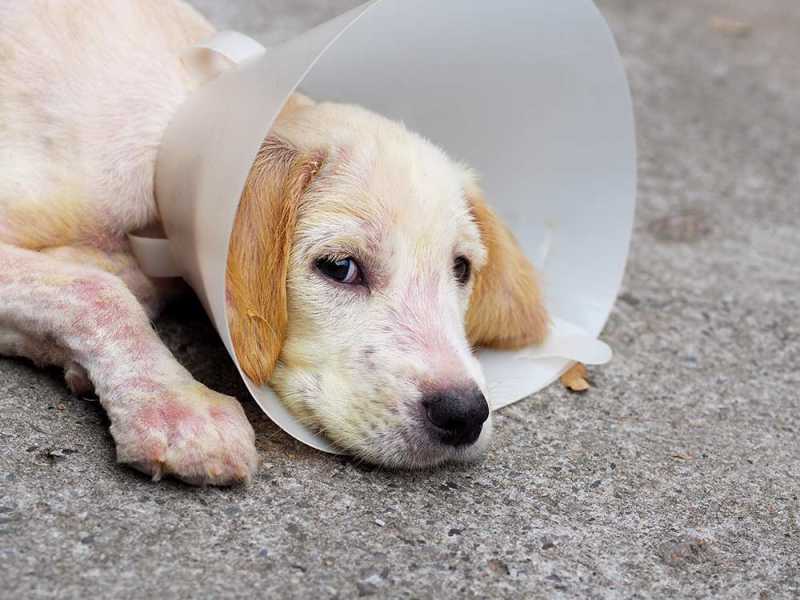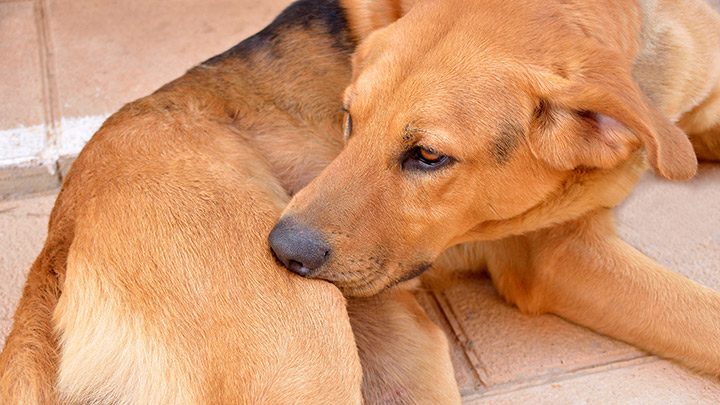Mange is a common contagious skin disease in dogs. Various species of parasitic mites burrow into your pup’s skin causing intense itching, inflammation, and hair loss. You may think it may not be so contagious that it could weaken your pup, dog, or your aged dog’s immune systems. It’s highly infectious and spreads quickly, especially in dog parks, shelters, and kennels. You may find different types of Manges unique to each other.
Types of Mange in Dogs
There are several types of mange in dogs, each caused by different mites and showing unique symptoms. Here are some of the most common types.
Sarcoptic Mange
Also, we call it canine scabies, Sarcoptes scabies mites cause sarcoptic. They dig into the skin, laying eggs and causing extreme itching and discomfort. Symptoms usually appear 10 days to 8 weeks after exposure, starting in less hairy areas like the ears, elbows, and abdomen, but can spread all over the body if untreated.
Sarcopotic Mange is very contagious. It spreads through direct contact or contaminated items like bedding and grooming tools. Humans can catch sarcoptic mange from infected dogs, it is less likely though, but the mites don’t survive long on human skin.
Demodectic Mange
Demodex canis mites cause Demodectic mange. They live in a dog’s hair follicles and oil glands. These mites are usually harmless, but when a dog’s immune system is weak, they can multiply and cause mange.
There are two types of demodectic mange:
- Localized demodicosis: This is common in puppies. It causes small patches of hair loss, usually on the face or legs, and often clears up on its own as the dog’s immune system matures.
- Generalized demodicosis: It can affect any dog and cause widespread hair loss, skin infections, and severe lesions. It’s often linked to an underlying immune issue.
Unlike sarcoptic mange, demodectic mange isn’t contagious and is usually passed from mother to puppy through close contact after birth.
Cheyletiellosis (Walking Dandruff)
It’s hilarious to find walking dandruff. But you could see them in dogs. They are the flakes of dandruff on the dog’s skin that move hitherto. It is caused by Cheyletiella. This type of mange is mildly contagious and can affect other pets and humans, but it’s usually more annoying than harmful. Dogs often experience itching and excessive scratching.
Otodectic mange
Otodectic mange, caused by Otodectes cynotis mites, primarily affects the ears. Symptoms include ear scratching, head shaking, and dark, crusty ear discharge. Left untreated, ear mites can lead to serious ear infections. It’s highly contagious among pets.
Symptoms of Mange in Dogs

The first sign of mange is usually constant itching. You may see that the affected dogs may scratch, bite, or chew their skin, often causing open sores or infections. Other symptoms include:
- Red, inflamed skin
- Hair loss in patches
- Scaly, crusty skin
- Skin thickening over time
- Sores or lesions
- Foul odor due to infections
- Restlessness or irritability
If you notice any of these symptoms, take your dog to the vet. The vet will perform a physical exam and may take skin scrapings or biopsies to confirm the presence of mites and diagnose the type of mange.
Causes of Mange in Dogs
Mange is caused by microscopic mites that live on or burrow into a dog’s skin. Dogs usually get mange through contact with an infected animal or contaminated items like bedding or grooming tools. It’s in crowded or unsanitary environments, such as shelters or kennels, where we can see an increase in the risk of infection. There are dogs with weakened immune systems due to age, illness, malnutrition, or stress. They are more likely to develop mange because their bodies can’t fight off the mites as easily.
Treatment Options for Mange in Dogs
If your dog is diagnosed with mange, you must promptly treat him to relieve his discomfort and prevent the condition from worsening. The vet may recommend one or more of the following treatments based on the type and severity of the mange:
- Medicated Baths and Dips: Your vet will recommend special shampoos or dips with ingredients like lime sulfur, amitraz, or benzoyl peroxide to help kill mites and soothe irritated skin. You may follow the instructions carefully to ensure effectiveness and safety.
- Oral Medications: The vet might prescribe oral medications like ivermectin or milbemycin to kill mites. These treatments can work faster, but should always be used under a vet’s supervision due to potential side effects.
- Topical Treatments: Topical treatments can be applied directly to your dog’s skin to eliminate mites. These treatments might include moxidectin or selamectin, which are usually applied every month.
- Antibiotics and Antifungals: If your dog has a secondary infection from scratching, the vet may prescribe antibiotics or antifungal medications to prevent further spreading and heal discomfort.
- Regular Grooming: Frequent brushing and grooming can help remove dead skin and soothe irritation. Use gentle products to avoid further irritation. Remember, you may use a gentle brush and avoid any products that could further irritate your dog’s skin.
Can Dogs Recover from Mange?

Yes, mange is treatable, and most dogs recover fully with proper care.
For sarcoptic mange, the prognosis is good with timely treatment. You should start seeing improvements within a few weeks, with full recovery expected in one to two months.
However, Demodectic mange can be more challenging to treat because it often requires addressing underlying immune system issues. Treatment for generalized demodectic mange can take several months, but localized cases may clear up on their own or with minimal intervention.
Early diagnosis and following the vet’s treatment plan are key to a quick recovery.
Preventing Mange in Dogs
After your dog has recovered, take these steps to prevent future outbreaks:
- Maintain Good Hygiene: Clean your dog’s living space regularly. Wash bedding, toys, and other items they come into contact with. Vacuum your home often and consider using mite-killing sprays, but make sure they’re safe for pets.
- Boost the Immune System: A strong immune system helps your dog fight off infections. Ensure that you feed your dog a nutritious diet, ensure they get regular exercise, and keep vaccinations up-to-date. Talk to your vet about supplements that could support their health.
- Use Preventive Treatments: Ask your vet about preventive shampoos or treatments that protect against mites. Keeping other parasites away is also crucial, as they can weaken the immune system.
- Limit Exposure to Infected Animals: As mange is a contagious disease, you may avoid letting your dog interact with animals that show signs of mange. If other pets or local animals seem infected, keep your dog away and inform your vet.
Remember, you must trust your vet and follow his or her advice for your dog’s well-being. Always consult them before trying any treatments or if you notice any unusual symptoms. Mange can mimic other skin conditions, so it’s important to get an accurate diagnosis and appropriate care to ensure your dog’s well-being.



